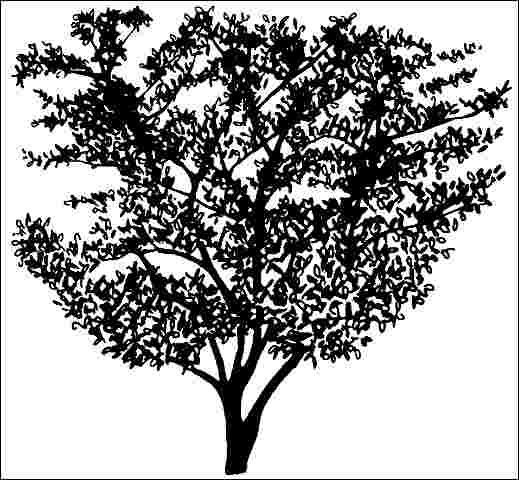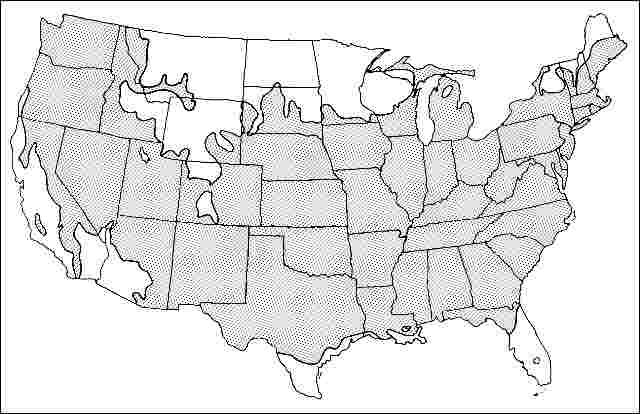Introduction
Crimson Cloud (also known as `Superba') English Hawthorn grows rapidly in a pyramidal form to about 20 feet, then the crown expands to become oval or irregular. The tree tolerates most soils, growing well in clay, but prefers heavy, dry loam. The main ornamental feature is white and red flowers borne in spring which together give the tree a deep pink color. Fruits are red and quite showy but do not cover the tree. Though quite ornamental, Hawthorns are susceptible to insect and disease problems. Branching habit is decidedly drooping and care should be given when locating this tree near pedestrian or vehicular traffic.

General Information
Scientific name: Crataegus laevigata
Pronunciation: kruh-TEE-gus lee-vih-GAY-tuh
Common name(s): 'Crimson Cloud' English Hawthorn
Family: Rosaceae
USDA hardiness zones: 4B through 8B (Fig. 2)
Origin: not native to North America
Invasive potential: little invasive potential
Uses: urban tolerant; Bonsai; street without sidewalk; reclamation; screen; espalier; sidewalk cutout (tree pit); tree lawn 3-4 feet wide; tree lawn 4-6 feet wide; tree lawn > 6 ft wide; highway median; specimen
Availability: not native to North America

Description
Height: 20 to 25 feet
Spread: 15 to 25 feet
Crown uniformity: irregular
Crown shape: pyramidal, oval
Crown density: moderate
Growth rate: moderate
Texture: fine
Foliage
Leaf arrangement: alternate (Fig. 3)
Leaf type: simple
Leaf margin: lobed, serrate
Leaf shape: ovate, obovate
Leaf venation: pinnate
Leaf type and persistence: deciduous
Leaf blade length: less than 2 inches
Leaf color: green
Fall color: no color change
Fall characteristic: not showy

Flower
Flower color: red, lavender
Flower characteristics: showy
Fruit
Fruit shape: round
Fruit length: less than .5 inch
Fruit covering: fleshy
Fruit color: red
Fruit characteristics: attracts birds; showy; fruit/leaves not a litter problem
Trunk and Branches
Trunk/bark/branches: branches droop; not showy; typically multi-trunked; no thorns
Pruning requirement: needed for strong structure
Breakage: resistant
Current year twig color: brown
Current year twig thickness: medium
Wood specific gravity: unknown
Culture
Light requirement: full sun
Soil tolerances: sand; loam; clay; acidic; alkaline; well-drained; occasionally wet
Drought tolerance: high
Aerosol salt tolerance: low
Other
Roots: not a problem
Winter interest: yes
Outstanding tree: no
Ozone sensitivity: unknown
Verticillium wilt susceptibility: resistant
Pest resistance: resistant to pests/diseases
Use and Management
The tree casts heavy shade, and turf can not be grown underneath, if lower branches are left on the trunk. Persistent lower branches add to the ornamental characteristic of the tree and it makes a nice specimen in a lawn for all seasons when left unpruned. When lower branches are removed in the nursery, this tough tree can be used as a street or parking lot tree where overhead space is limited by powerlines or other features. Be sure to order single-trunked trees clear of lower branches when planting along a street to provide for adequate clearance. Branches on the species bear sharp thorns which can inflict pain as they meet flesh, but this cultivar is almost thornless. Grows well in tree pits and other confined soil spaces. Plant in the open with good air circulation to help reduce disease, since leaf diseases can be common.
A number of other cultivars are offered in garden centers: `Flore-Plena - double, white flowers; `Gireoudii' - foliage variegated, white flowers, large red fruit; `Masekii' - pale rose, double flowers; `Paulii' (`Paul's Scarlet') - deep pink, double flowers; `Pendula' - weeping growth habit; `Punica' - single, pink flowers; `Rosea' - pink flowers; `Stricta' - upright growth habit.
Pests
Aphids on small trees can be partially controlled with strong sprays of water from a garden hose, if the colony is in the lower branches. Sometimes the aphids themselves are not seen but the distorted growth, honeydew on the leaves, and sooty mold growing on the honeydew are obvious.
Borer attacks may be prevented if the trees are kept in good vigor with regular fertilization.
Leaf miners symptoms are brown blotches on the leaves.
Lace bugs can be a serious, though occasional, problem. The insect feeding on the undersides of the leaves causes chlorotic flecks on the upper leaf surfaces. The lower sides of the leaves are covered with small, brown, sticky flecks.
The pear slug skeletonizes Hawthorn leaves and these sawfly larvae have a slimy appearance. A few insects can be washed off with a garden hose.
Tent caterpillar nests can be pruned out while still small. Sprays of Bacillus thuringiensis may be used. Do not burn nests while the nests are in the tree. The injury from the fire may exceed that caused by the insects.
Scales may be controlled with horticultural oil sprays.
Spider mites are so small they can cause much foliage discoloration before being detected.
Diseases
Fire blight: This disease can be severe in some parts of the country. The first noticeable symptom of fire blight is the browning of branch tips. The tips appear to be burned or scorched and the dead, brown leaves droop but hang on the tree. Cankers form and the bacteria is washed farther down the branch by rain. The bacteria, Erwinia amylovora , are spread from diseased to healthy twigs by rain, bees, and other mechanical means. There is no satisfactory chemical control. The disease is less of a problem if trees are not located near apple or pear orchards. Prune out blighted branch tips by cutting a foot or two beyond the diseased wood. Over-fertilizing with nitrogen fertilizer may increase tree susceptibility to fire blight.
Leaf blight attacks most Hawthorns but especially English Hawthorn. `Crimson Cloud' is reported to be resistant. The symptoms are small reddish brown spots on the leaves which may run together. Infected leaves drop in August and severely infected trees may be completely bare.
Cedar Hawthorn rust causes orange or rust colored spots on the leaves leading to early defoliation. The fruits and twigs are also attacked. Juniper is an alternate host. Cedar-quince rust attacks fruits. Washington, Lavelle and Cockspur Hawthorn are resistant to rust diseases.
Scab causes leaf spotting and defoliation. The fruit have black raised spots on them.
Powdery mildew causes a white powdery growth on the leaves.